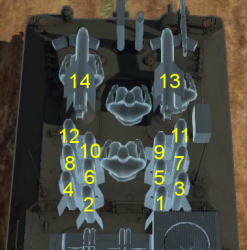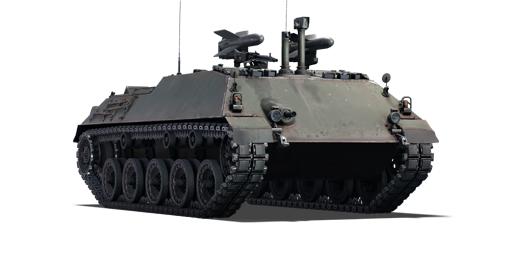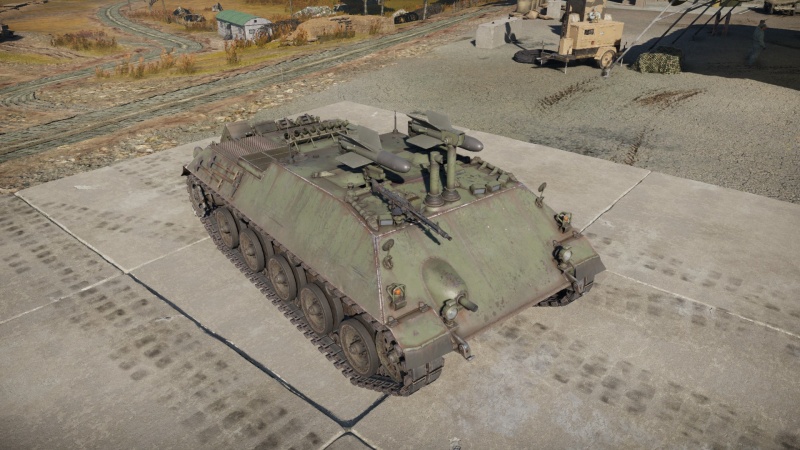RakJPz 2
| This page is about the German tank destroyer RakJPz 2. For the other version, see RakJPz 2 (HOT). |
Contents
Description
The Raketenjagdpanzer 2 (RakJPz 2) is a rank German tank destroyer with a battle rating of (AB), (RB), and (SB). It was introduced in Update 1.59 "Flaming Arrows". Featuring the SS.11 anti-tank guided missile, the Raketenjagdpanzer 2 serves as the missile's mobile platform. While lethal, the missile has to be manually guided and leaves the weak hull vulnerable as the operator steers the missile into the target.
General info
Survivability and armour
Armour type:
- Rolled homogeneous armour
| Armour | Front | Sides | Rear | Roof |
|---|---|---|---|---|
| Hull | 50 mm (51°) Front glacis 50 mm (54°) Lower glacis |
30 mm (35°) Top 30 mm Bottom |
30 mm (44°) Top 30 mm (41°) Bottom |
10 mm |
Notes:
- Suspension wheels are 15 mm thick while tracks are 20 mm thick.
- Belly armour is 10 mm thick.
Mobility
| Game Mode | Max Speed (km/h) | Weight (tons) | Engine power (horsepower) | Power-to-weight ratio (hp/ton) | |||
|---|---|---|---|---|---|---|---|
| Forward | Reverse | Stock | Upgraded | Stock | Upgraded | ||
| Arcade | Expression error: Unexpected * operator. | 710 | Expression error: Unexpected round operator. | __.__ | |||
| Realistic | 442 | Expression error: Unexpected round operator. | __.__ | ||||
Modifications and economy
Armaments
Main armament
| Dual LFK SS.11 ATGM | Turret rotation speed (°/s) | Reloading rate (seconds) | |||||||||||
|---|---|---|---|---|---|---|---|---|---|---|---|---|---|
| Mode | Capacity | Vertical | Horizontal | Stabilizer | Stock | Upgraded | Full | Expert | Aced | Stock | Full | Expert | Aced |
| Arcade | 14 | -10°/+20° | Left: -90°/+10° Right: -10°/+90° |
N/A | 22.0 | 30.5 | 37.0 | 40.9 | 43.5 | 26.00 | 23.00 | 21.20 | 20.00 |
| Realistic | 14.9 | 17.5 | 21.2 | 23.5 | 25.0 | ||||||||
Ammunition
| Penetration statistics | |||||||
|---|---|---|---|---|---|---|---|
| Ammunition | Type of warhead |
Penetration @ 0° Angle of Attack (mm) | |||||
| 10 m | 100 m | 500 m | 1,000 m | 1,500 m | 2,000 m | ||
| LFK SS.11 | ATGM | 600 | 600 | 600 | 600 | 600 | 600 |
| Missile details | ||||||||||
|---|---|---|---|---|---|---|---|---|---|---|
| Ammunition | Type of warhead |
Velocity (m/s) |
Range (m) |
Projectile mass (kg) |
Fuse delay (m) |
Fuse sensitivity (mm) |
Explosive mass (TNT equivalent) (g) |
Ricochet | ||
| 0% | 50% | 100% | ||||||||
| LFK SS.11 | ATGM | 190 | 3,500 | 29.99 | 0.05 | 0.1 | 2,000 | 80° | 82° | 90° |
Ammo racks

| Full ammo |
Visual discrepancy |
|---|---|
| 14 | No |
Notes:
- It is not possible to select how many missiles to bring into battle.
- Missiles are modeled individually and disappear after having been shot or loaded.
- When restocking missiles at a capture point, all missiles for the right launcher will be loaded first (even numbers), then all missiles for the left launcher (odd numbers).
Machine guns
| 7.62 mm MG3A1 | ||||
|---|---|---|---|---|
| Mount | Capacity (Belt) | Fire rate | Vertical | Horizontal |
| Pintle | 2,600 (200) | 1,200 | -5°/+25° | ±45° |
Usage in battles
Describe the tactics of playing in the vehicle, the features of using vehicles in the team and advice on tactics. Refrain from creating a "guide" - do not impose a single point of view but instead give the reader food for thought. Describe the most dangerous enemies and give recommendations on fighting them. If necessary, note the specifics of the game in different modes (AB, RB, SB).
Pros and cons
Pros:
- Missiles can penetrate 600 mm of armour, stronger than other wire guided missiles (which generally have up to 500 mm penetration)
- Missiles have a 180 degree firing arc and can be used as a close-range weapon if necessary
- Two missiles on top allow for rapid follow-up shots and have combined reload rate of 10 seconds if chain fired
- Can potentially curve the missiles into targets behind cover, as missiles have great horizontal mobility
- Shares the same chassis as the Jpz 4-5, inheriting its mobility and low profile, allowing the tank to sneak around and only expose missiles and periscope in many situations, making it exceptionally dangerous behind a low cover or an uphill facing downwards
- Excels in maps with a lot of open grounds
- Has rapid firing smoke grenades
- ATGMs are free and cost nothing to fire
Cons:
- In RB/SB, missiles are manually guided, making them harder to aim at longer distance, especially at moving targets. Guiding them in these modes also leaves tank stationary and vulnerable
- Controls for missiles are very sensitive and in RB/SB its Y axis (up/down) is inverted
- Missile platform cannot traverse past sides
- Very thin armour, very vulnerable to autocannons (although this rarely matters as it relies on concealment to ambush and deal damage)
- Very little empty space inside, penetrating shots are going to hit crew, ammo, or both
- Missiles on top act as exterior ammo racks and can be detonated
- In Arcade Battle aim assist allows enemy to directly aim at periscope and make normally extremely unlikely hit with HESH or HE, instantly obliterating the tank, which reduces it's hulldown potential at close range
- Unable to fire missiles if the launchers are damaged, will require repairs first, which takes time
- 14 missile stowage - each launcher carries 7 ammo, ammo from one launcher cannot be used by another, which can be an issue if user happened to only fire one of them during long fight
- Optics prevent the missiles from being fired simultaneously at a certain angle and direction
- Can't fire on the move
History
Development
In the 1960s, the German Bundeswehr commenced the development of a missile carrier to fit in a role of a tank destroyer. The result came in 1961 with the Raketenjagdpanzer 1, which features the French SS.11 anti-tank missile. The Raketenjagdpanzer 1 features two mounts for the missiles, but only one is available at a time as while one remains ready to fire, the other is reloading inside the vehicle. The vehicle can hold 10 missiles inside the Hispano-Suiza HS-30 chassis. It also carried existing problems with the HS-30 chassis so only a limited amount of 95 vehicles was produced from 1961 to 1962. A second improved version was designed alongside the Jagdpanzer 4-5 between 1963 and 1965, and the two were designed on the same chassis. The finished model was designated the Raketenjagdpanzer 2 and this was accepted into Bundeswehr service in 1967. The Raketenjagdpanzer 2 were produced from 1967 to 1968 for a total of 318 units produced.
Design
Though slightly larger than the Raketenjagdpanzer 1, the Raketenjagdpanzer 2 had better automotive performances with the newer chassis and a 500 hp diesel engine and torsion bar suspension. The new vehicle chassis design allowed for an increased missile storage of 14 SS.11 missiles. The Raketenjagdpanzer 2 featured two rails for the missiles, both ready to fire and reloads are done automatically by each mount inside the vehicle. The SS.11 missiles allow the vehicle to engage enemy armour up to 3 kilometers away, with the missiles penetrating 600 mm of armour on impact, enough to take out most Soviet armour at the time. For personnel protection, a MG3 machine gun was also available for anti-infantry and anti-aircraft defense purposes.
Usage
The German Bundeswehr used the Raketenjagdpanzer 2 from 1967 as far as to the 1990s. The Raketenjagdpanzer 2's purpose was to engage enemy armour in the ranges between 1.5 to 3 kilometers away, which regular tank armaments' accuracy and power are reduced at the distances. The SS.11 missile's range and lethality made the Raketenjagdpanzer 2 perfect for its role as it could defeat the main Soviet tanks such as the T-54/55 and T-62. The Germans organized the Raketenjagdpanzer 2 in tank destroyer companies attached to Panzergrenadier brigades and Panzer brigades, with eight vehicles per company in the Panzergrenadier brigades and 13 vehicles per company in the Panzer brigades. When the manual-guided SS.11 missiles became obsolete, the Raketenjagdpanzer 2 underwent an upgrade between 1978 and 1982 in armour and in its missile armament from the SS.11 to the HOT (High Subsonic Optical Remote-Guided, Tube-Launched) missiles with improved lethality and guidance system. The upgraded Raketenjagdpanzer 2 was redesignated into the Raketenjagdpanzer 2 HOT. This saw an improvement again between 1993 and 1995 when some extra armour, a new optic, and thermal imaging system were installed into the vehicle, turning it into the Raketenjagdpanzer Jaguar 1. The Raketenjagdpanzers were all retired by the end of the 1990s, never seeing combat in the Cold War.
Media
- Skins
See also
Links to the articles on the War Thunder Wiki that you think will be useful for the reader, for example:
- reference to the series of the vehicles;
- links to approximate analogues of other nations and research trees.
External links
| Germany tank destroyers | |
|---|---|
| Pz. I Derivatives | Panzerjäger I |
| Pz. II Derivatives | 15cm sIG 33 B Sfl |
| Pz. 38(t) Derivatives | Marder III · Marder III H · Jagdpanzer 38(t) |
| Pz. III Derivatives | StuG III A · StuG III F · StuG III G · StuH 42 G |
| Pz. IV Derivatives | Jagdpanzer IV · Panzer IV/70(A) · Panzer IV/70(V) · Dicker Max · Nashorn · Brummbär · VFW |
| Pz. V Derivatives | Jagdpanther G1 · Bfw. Jagdpanther G1 |
| Pz. VI Derivatives | Sturer Emil · Elefant · Ferdinand · 38 cm Sturmmörser · Jagdtiger |
| Wheeled/Half-track | 8,8 cm Flak 37 Sfl. · Sd.Kfz.251/9 · Sd.Kfz.251/10 · Sd.Kfz.251/22 · Sd.Kfz.234/3 · Sd.Kfz.234/4 · 15 cm Pz.W.42 |
| ATGM Carrier | RakJPz 2 · RakJPz 2 (HOT) · Wiesel 1A2 |
| Other | Waffenträger · M109G · JPz 4-5 · Raketenautomat · VT1-2 |






